Color mutations
In very rare cases some donkey colors and markings can be affected by mutations. These are basically genetic anomalies that alter the hue and tone of the entire body like a filter, or cause interesting mixed markings. So far there are five different mutations known.
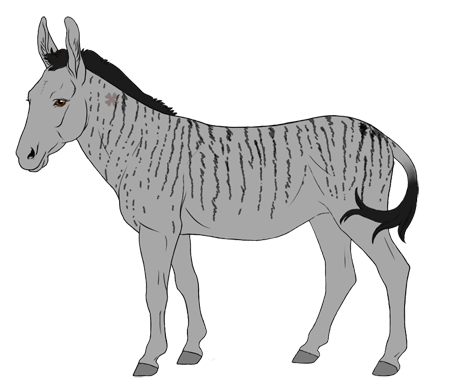 Variegate (brindle)
Variegated coloring consists of irregular stripes that extend vertically over the donkey's body and horizontally around the legs. The pattern usually does not affect the head (which usually becomes solid colored) and legs as much as the body, with the heaviest concentrations of variegated being on the neck, shoulders and hindquarters. It has no effect on dark or light points. Some variegated donkeys are more eye-catching than others and these are in most cases jennys. The variegate (evg) mutation is in the middle of the E locus, recessive to E but dominant over e. If a donkey is evgevg or evge then it will display its A locus genes, just like an ee donkey, but any red in the coat will be brindled. It usually shows itself as sooty or dark vertical lines on a lighter-colored coat. Variegated is not to be confused with the Zebardi marking which never goes beyond the legs and head. Also not to be confused with the dorsal barbs on an extended dun. In the later case, the donkey can show 'stripes' from both variegated and dun at the same time, but the dun stripes are wider and shorter. In summary, a variegated donkey is usually red or bay (with or without dun, dilute genes etc) with black uneven 'stripes'. These stripes will never be straight or even, they are more like jagged 'lines' of dark color or intense spotting. A jenny will always have more of these stripes than a jack. If one or both parents are spotted then the resulting foal - if variegated - can become a 'spotted' variegate. Instead of getting stripes it gets big patches of color replacing the white of a normal spotted Drabardi. The patches can have smooth or jagged edges. 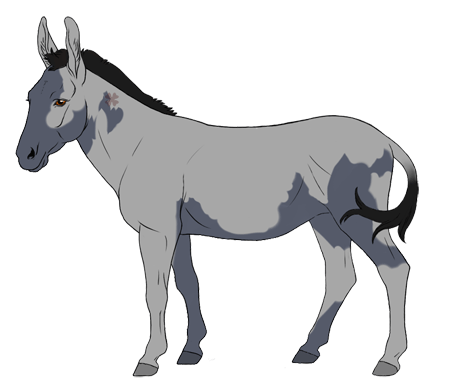
|
 SomaticThe somatic mutation is the result of a gene that is accidentally turned 'off'. It often results in odd patches of color on an otherwise ordinary coat. Somatic markings can manifest as either a patch or 'stripe' (similar to the brindle but not as extensive). The patch or patches cannot cover more than 25% of the donkey's body.
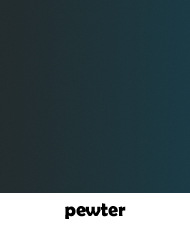 Pewter (Melanistic)Pewter is a melanistic mutation that covers most other markings. It will coat the entire donkey in a dark (somewhat blue-black) color and any markings will only show faintly underneath. The dark "pewter" colored layer (if you prefer to color the donkey as normal and just add a dark layer) should be at about 60-70% opacity. Any markings will still be visible and follow thei guidelines but all markings (and the basecoat) should be darker than normal. What become darker and what doesn't?Not affected: Any white markings such as roan or spotted will still cover the donkey as normal. Only the colored parts are affected.
Affected: All markings, even points. The donkey's mane and tail-switch are both affected.
For a Drabardi to have a higher chance of being pewter (melanistic) one of its parents needs to carry the mutation (similar to Chiffon), however the likelihood of inheriting it is still small.
The odds are raised slightly for each ancestor donkey within three generations that also has the mutation. For example, if one of the donkey's parents, grandparents and/or great-grandparents were pewter/melanistic it will have a higher chance of inheriting this trait.
|
|||||||||||||||||||||
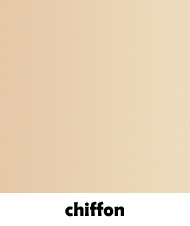 Chiffon (Leucism)If the donkey has full chiffon (leucism), all its markings will show faintly but they will get a golden like hue or look a little washed out. However, the markings must still be easily identifiable. Partial chiffon behaves the same as full but instead of covering the whole body it just appears in patches. For a Drabardi to have a higher chance of being chiffon one of its parents needs to carry the mutation (similar to Pewter), however the likelihood of inheriting it is still small. The odds are raised slightly for each ancestor donkey within three generations that also has the mutation. For example, if one of the donkey's parents, grandparents and/or great-grandparents were chiffonitic it will have a higher chance of inheriting this trait. What becomes lighter and what doesn't? Not affected: Any white markings such as roan or spotted will still cover the donkey as normal. Only the colored parts are affected. Sometimes it can be hard to see the edges of white markings on a full chiffon donkey unless it is wet (similar to an appaloosa horse's spots after they've been hosed down). Affected: All markings, even points. The donkey's mane and tail-switch are also affected by chiffon. The mutation will give the donkey a pale creamy color (or in the case of partial, a pale creamy patch), including the mane/tail. It also makes the donkey's eye color roughly 50% lighter than normal if the chiffon mutation covers the skin around the eye. The partial chiffon markings usually have a slightly blurred edge. 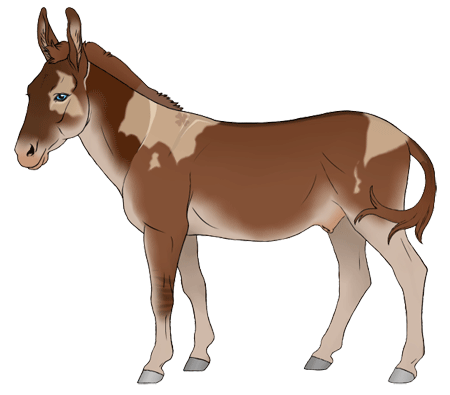 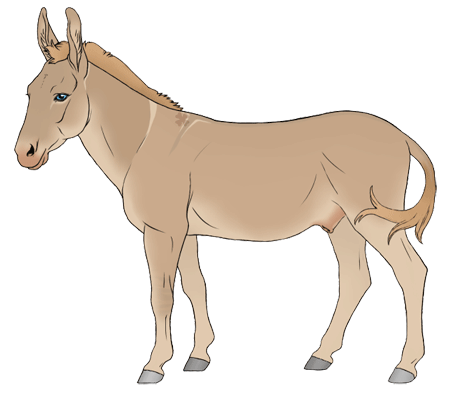 Left: Partial Chiffon over Nila Flaxen Red Dun Collared with accents
Right: Full Chiffon over Nila Flaxen Red Dun Collared with accents
Left: Partial Chiffon over Nila Flaxen Red Dun Collared with accents
Right: Full Chiffon over Nila Flaxen Red Dun Collared with accents
|
 Bole (Erythrism)This mutation causes an excessive production of reddish pigmentation. This red hue affects black-based donkeys, making them look more dark red-bay than black, and so they are easily mistaken for bays. The effect is not as dramatic on a bay donkey, but a bay bole coat will usually have a bit more red to it. On a red-based donkey it wont show much at all and in many cases the marking has gone unnoticed on such animals. Before the mutation was identified some donkeys were deemed uncharacteristic of the breed standards due to these deviations in coat color. There are still those who won't rank a bole donkey as highly as one without it. A donkey's markings will only show faintly beneath the bole layer, similar to the other color mutations (pewter and chiffon). White markings are not affected. What becomes more red and what doesn't? Not affected: Any white markings such as roan or spotted will still cover the donkey as normal. Only the colored parts are affected. Reddened: All markings, even points. The donkey's mane and tail-switch are also affected. For a Drabardi to have a higher chance of inheriting the bole marking, one of its parents needs to carry the mutation as well (similar to Pewter). The chances are still small however. 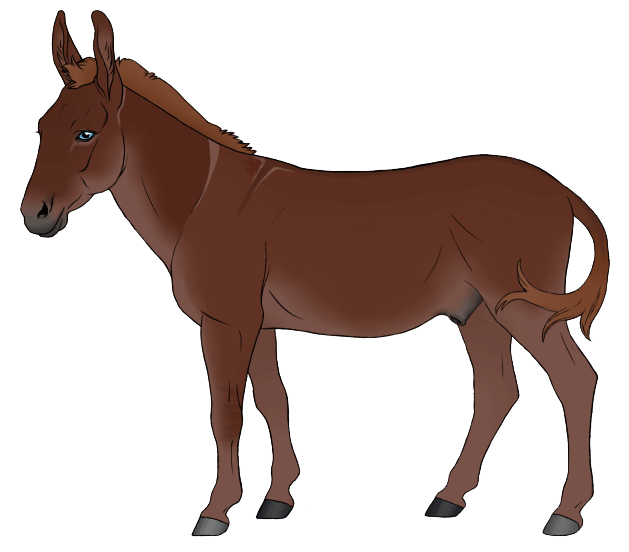 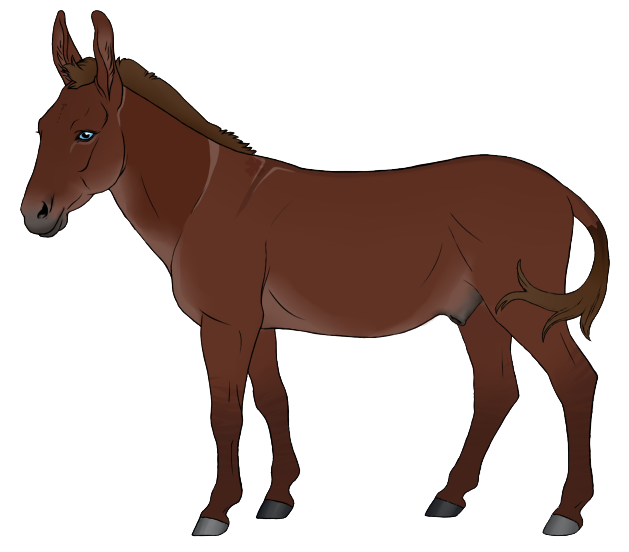 Left: Bole over Nila Bay Dun Collared with pangare and accents
Right: Bole over Nila Flaxen Red Dun Collared with pangare and accents.
The above is showing the likeness between a true red donkey and a blackbased one with bole.
Left: Bole over Nila Bay Dun Collared with pangare and accents
Right: Bole over Nila Flaxen Red Dun Collared with pangare and accents.
The above is showing the likeness between a true red donkey and a blackbased one with bole.
|
Don't forget - The examples shown are without a Drabardi hue added.The illustrations are simply examples, for more inspiration on different shades etc, look up sooty in horses!
 Pewter over Nila Flaxen Red Dun Collared with accents
Pewter over Nila Flaxen Red Dun Collared with accents